英语科技论文的基本结构及其要点共30页
- 格式:ppt
- 大小:2.62 MB
- 文档页数:30
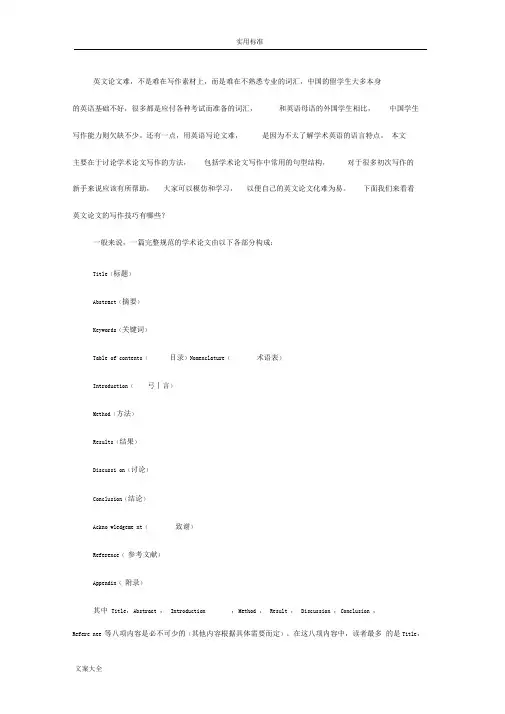
英文论文难,不是难在写作素材上,而是难在不熟悉专业的词汇,中国的留学生大多本身的英语基础不好,很多都是应付各种考试而准备的词汇,和英语母语的外国学生相比,中国学生写作能力则欠缺不少。
还有一点,用英语写论文难,是因为不太了解学术英语的语言特点。
本文主要在于讨论学术论文写作的方法,包括学术论文写作中常用的句型结构,对于很多初次写作的新手来说应该有所帮助,大家可以模仿和学习,以便自己的英文论文化难为易。
下面我们来看看英文论文的写作技巧有哪些?一般来说,一篇完整规范的学术论文由以下各部分构成:Title(标题)Abstract(摘要)Keywords(关键词)Table of contents(目录)Nomenclature(术语表)Introduction(弓丨言)Method(方法)Results(结果)Discussi on(讨论)Conclusion(结论)Ackno wledgeme nt(致谢)Reference(参考文献)Appendix(附录)其中Title,Abstract ,Introduction ,Method ,Result ,Discussion ,Conclusion ,Refere nee 等八项内容是必不可少的(其他内容根据具体需要而定)。
在这八项内容中,读者最多的是Title,Abstract和Introduction 部分,读者会根据这些内容来决定是否阅读全文。
也就是说,一篇研究论文赢得读者的多少,在很大程度上取决于Title , Abstract和Introduction 写得好坏。
因此这三项内容将各分章详细加以讲述。
学术论文的正文一般包括Method ,Result ,Discussion 三个部分。
这三部分主要描述研究课题的具体内容、方法,研究过程中所使用的设备、仪器、条件,并如实公布有关数据和研究结果等。
Con clusi on 是对全文内容或有关研究课题进行的总体性讨论。
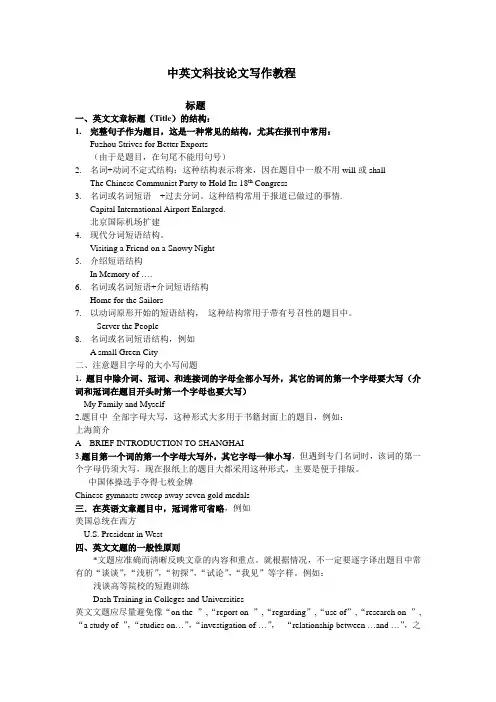
中英文科技论文写作教程标题一、英文文章标题(Title)的结构:1.完整句子作为题目,这是一种常见的结构,尤其在报刊中常用:Fuzhou Strives for Better Exports(由于是题目,在句尾不能用句号)2.名词+动词不定式结构:这种结构表示将来,因在题目中一般不用will或shallThe Chinese Communist Party to Hold Its 18th Congress3.名词或名词短语+过去分词。
这种结构常用于报道已做过的事情.Capital International Airport Enlarged.北京国际机场扩建4.现代分词短语结构。
Visiting a Friend on a Snowy Night5.介绍短语结构In Memory of ….6.名词或名词短语+介词短语结构Home for the Sailors7.以动词原形开始的短语结构,这种结构常用于带有号召性的题目中。
Server the People8.名词或名词短语结构,例如A small Green City二、注意题目字母的大小写问题1. 题目中除介词、冠词、和连接词的字母全部小写外,其它的词的第一个字母要大写(介词和冠词在题目开头时第一个字母也要大写)My Family and Myself2.题目中全部字母大写,这种形式大多用于书籍封面上的题目,例如:上海简介A BRIEF INTRODUCTION TO SHANGHAI3.题目第一个词的第一个字母大写外,其它字母一律小写,但遇到专门名词时,该词的第一个字母仍须大写,现在报纸上的题目大都采用这种形式,主要是便于排版。
中国体操选手夺得七枚金牌Chinese gymnasts sweep away seven gold medals三.在英语文章题目中,冠词常可省略,例如美国总统在西方U.S. President in West四、英文文题的一般性原则*文题应准确而清晰反映文章的内容和重点。
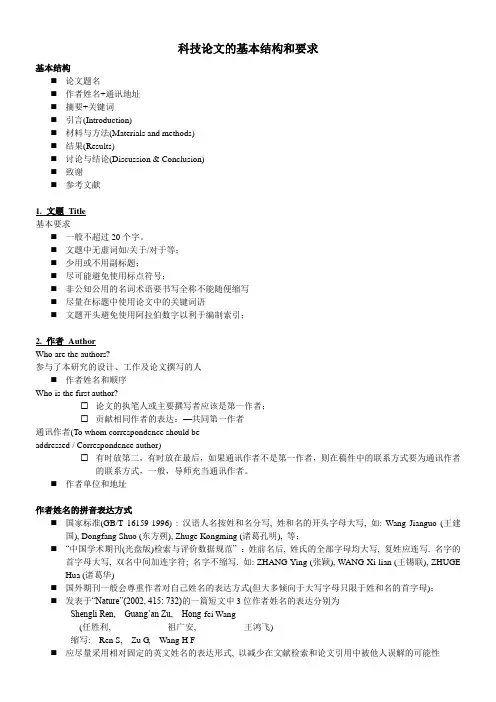
科技论文的基本结构和要求基本结构⏹论文题名⏹作者姓名+通讯地址⏹摘要+关键词⏹引言(Introduction)⏹材料与方法(Materials and methods)⏹结果(Results)⏹讨论与结论(Discussion & Conclusion)⏹致谢⏹参考文献1. 文题Title基本要求⏹一般不超过20个字。
⏹文题中无虚词如/关于/对于等;⏹少用或不用副标题;⏹尽可能避免使用标点符号;⏹非公知公用的名词术语要书写全称不能随便缩写⏹尽量在标题中使用论文中的关键词语⏹文题开头避免使用阿拉伯数字以利于编制索引;2. 作者AuthorWho are the authors?参与了本研究的设计、工作及论文撰写的人⏹作者姓名和顺序Who is the first author?☐论文的执笔人或主要撰写者应该是第一作者;☐贡献相同作者的表达:—共同第一作者通讯作者(To whom correspondence should beaddressed / Correspondence author)☐有时放第二,有时放在最后,如果通讯作者不是第一作者,则在稿件中的联系方式要为通讯作者的联系方式,一般,导师充当通讯作者。
⏹作者单位和地址作者姓名的拼音表达方式⏹国家标准(GB/T 16159-1996) : 汉语人名按姓和名分写, 姓和名的开头字母大写, 如: Wang Jianguo (王建国), Dongfang Shuo (东方朔), Zhuge Kongming (诸葛孔明), 等;⏹“中国学术期刊(光盘版)检索与评价数据规范” :姓前名后, 姓氏的全部字母均大写, 复姓应连写. 名字的首字母大写, 双名中间加连字符; 名字不缩写. 如: ZHANG Ying (张颖), WANG Xi-lian (王锡联), ZHUGE Hua (诸葛华)⏹国外期刊一般会尊重作者对自己姓名的表达方式(但大多倾向于大写字母只限于姓和名的首字母);⏹发表于“Nature”(2002, 415: 732)的一篇短文中3位作者姓名的表达分别为Shengli Ren, Guang’an Zu, Hong-fei Wang(任胜利, 祖广安, 王鸿飞)缩写: Ren S, Zu G, Wang H F⏹应尽量采用相对固定的英文姓名的表达形式, 以减少在文献检索和论文引用中被他人误解的可能性作者地址的标署⏹尽可能地给出详细的通讯地址;⏹如果论文出版时作者调到一个新的地址, 新地址应以“Present address”(现地址)的形式在脚注中给出;⏹如果第一作者不是通讯作者, 作者应按期刊的相关规定表达, 并提前告诉编辑. 期刊多以星号(*)、脚注或致谢的形式标注通讯作者或联系人3. 摘要Abstract摘要的定义:作者研究过程、研究目的、研究方法和研究结果的简要陈述和概括。
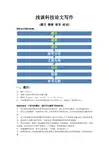
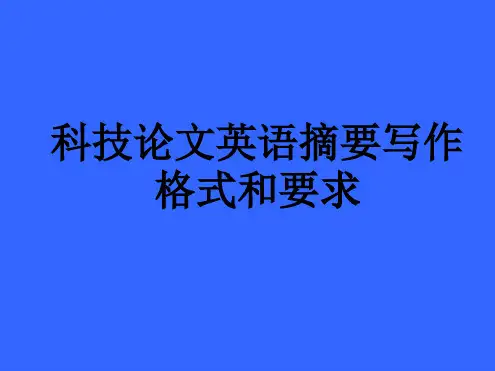
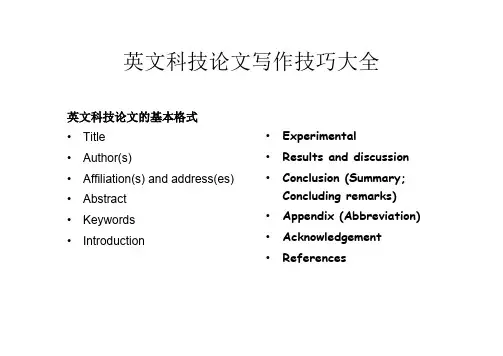
英文科技论文写作技巧大全英文科技论文的基本格式•Title•Author(s)•Affiliation(s) and address(es) •Abstract•Keywords•Introduction •Experimental •Results and discussion •Conclusion (Summary;Concluding remarks) •Appendix (Abbreviation)•Acknowledgement •References2.基本要求(1)Title长短适中,概括性强,重点突出,一目了然。
(2)Author(s)姓氏和名字要容易弄清楚,以免发生以名代姓。
(3)Affiliation(s) and address(es)准确清楚,使读者能按所列信息顺利地与作者联系。
(4)Abstract不宜太详尽,也不宜太简短,应将论文的研究体系、主要方法、重要发现、主要结论等,简明扼要地加以概括。
不要将结论与提要重复使用。
(5)Introduction说明本研究的目的意义。
归纳与本研究密切相关的前人研究结果及有关文献,指出本研究与前人研究的不同之处。
说明本论文要解决的问题及方法、手段等。
不宜将本论文的结果在“绪论”中叙述。
(6)Experimental叙述主要的实验过程、方法、仪器设备、试剂来源及规格等。
不宜将实验结果在“实验部分”中叙述。
(7)Results and discussion是论文的核心部分,要求:–数据及图表的内容及含义交代清楚,有条理;–对数据及现象的归纳、演绎、解释、立论要有逻辑性、自洽性。
–语句要准确、流畅、多样化,不宜重复使用相同的句型和词汇。
(8)Conclusion (Summary, Concluding remarks)简明扼要地归纳出本论文的新发现、新观点、新理论等。
不宜将“结果及讨论”部分的语句直接抄录作为结论。
(9)References要按所投杂志规定的格式准确书写。
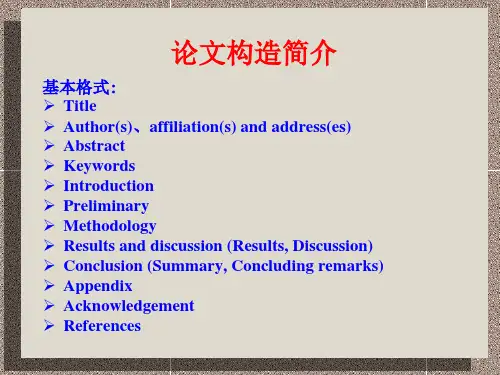
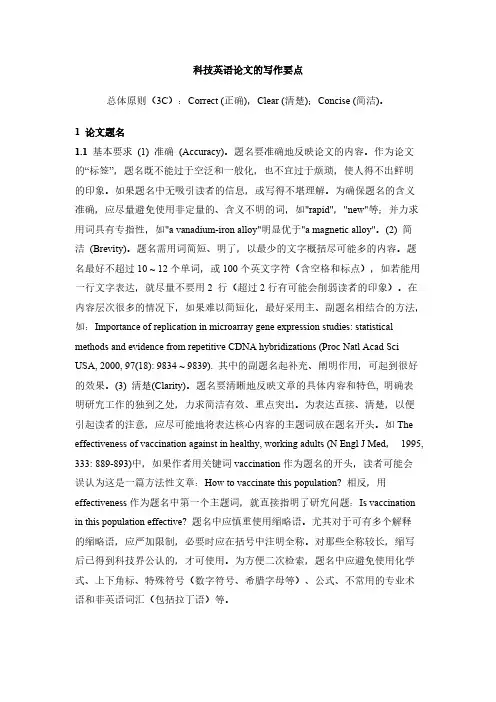
科技英语论文的写作要点总体原则(3C):Correct (正确),Clear (清楚);Concise (简洁)。
1 论文题名1.1 基本要求(1) 准确(Accuracy)。
题名要准确地反映论文的内容。
作为论文的“标签”,题名既不能过于空泛和一般化,也不宜过于烦琐,使人得不出鲜明的印象。
如果题名中无吸引读者的信息,或写得不堪理解。
为确保题名的含义准确,应尽量避免使用非定量的、含义不明的词,如"rapid","new"等;并力求用词具有专指性,如"a vanadium-iron alloy"明显优于"a magnetic alloy"。
(2) 简洁(Brevity)。
题名需用词简短、明了,以最少的文字概括尽可能多的内容。
题名最好不超过10 ~ 12个单词,或100个英文字符(含空格和标点),如若能用一行文字表达,就尽量不要用2 行(超过2行有可能会削弱读者的印象)。
在内容层次很多的情况下,如果难以简短化,最好采用主、副题名相结合的方法,如:Importance of replication in microarray gene expression studies: statistical methods and evidence from repetitive CDNA hybridizations (Proc Natl Acad Sci USA, 2000, 97(18): 9834 ~ 9839). 其中的副题名起补充、阐明作用,可起到很好的效果。
(3) 清楚(Clarity)。
题名要清晰地反映文章的具体内容和特色, 明确表明研究工作的独到之处,力求简洁有效、重点突出。
为表达直接、清楚,以便引起读者的注意,应尽可能地将表达核心内容的主题词放在题名开头。
如The effectiveness of vaccination against in healthy, working adults (N Engl J Med,1995, 333: 889-893)中,如果作者用关键词vaccination作为题名的开头,读者可能会误认为这是一篇方法性文章:How to vaccinate this population? 相反,用effectiveness作为题名中第一个主题词,就直接指明了研究问题:Is vaccination in this population effective? 题名中应慎重使用缩略语。
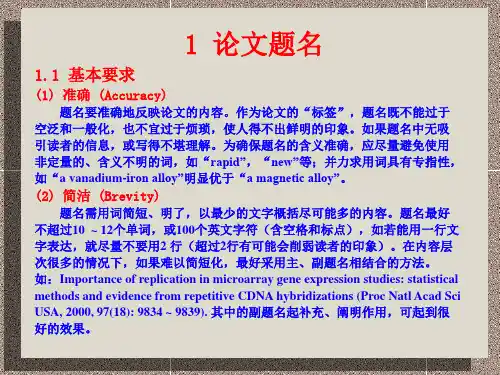
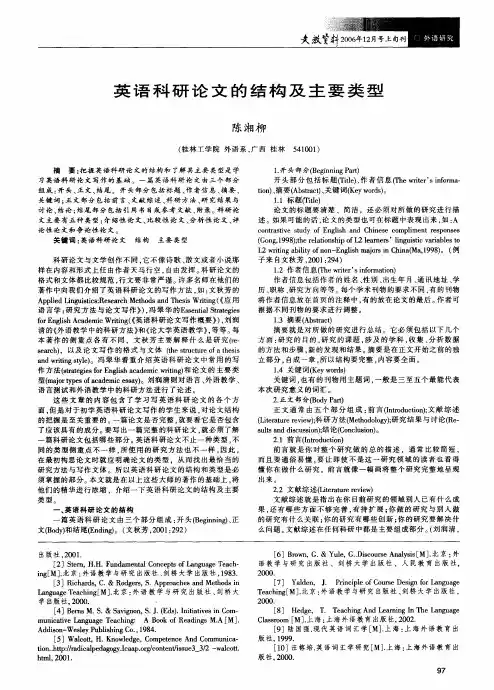
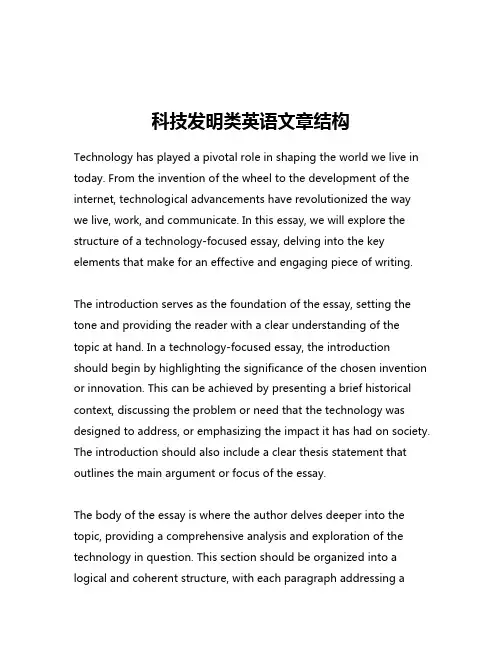
科技发明类英语文章结构Technology has played a pivotal role in shaping the world we live in today. From the invention of the wheel to the development of the internet, technological advancements have revolutionized the way we live, work, and communicate. In this essay, we will explore the structure of a technology-focused essay, delving into the key elements that make for an effective and engaging piece of writing.The introduction serves as the foundation of the essay, setting the tone and providing the reader with a clear understanding of the topic at hand. In a technology-focused essay, the introduction should begin by highlighting the significance of the chosen invention or innovation. This can be achieved by presenting a brief historical context, discussing the problem or need that the technology was designed to address, or emphasizing the impact it has had on society. The introduction should also include a clear thesis statement that outlines the main argument or focus of the essay.The body of the essay is where the author delves deeper into the topic, providing a comprehensive analysis and exploration of the technology in question. This section should be organized into a logical and coherent structure, with each paragraph addressing aspecific aspect of the technology. One effective approach is to divide the body into three or more main sections, each focusing on a different element of the technology.The first section of the body might provide a detailed description of the technology itself, including its key features, components, and underlying principles. This could involve explaining the scientific or engineering principles that govern the technology, as well as highlighting any innovative or unique aspects that set it apart from previous or competing technologies.The second section could then examine the development and evolution of the technology, tracing its historical origins and the key milestones or breakthroughs that have shaped its progress over time. This might include discussing the individuals or teams responsible for the technology's creation, the challenges they faced, and the innovative solutions they developed to overcome those challenges.The third section could explore the real-world applications and impact of the technology, discussing how it has been implemented and utilized in various industries, fields, or aspects of daily life. This could involve examining the technology's role in addressing specific problems or needs, its economic or social implications, and the ways in which it has transformed the way we live and work.Throughout the body of the essay, it is important to maintain a clear and coherent flow, using transitions and logical connections to guide the reader through the various sections and ideas. Additionally, the author should strive to provide a balanced and objective analysis, acknowledging both the benefits and potential drawbacks or limitations of the technology being discussed.The conclusion of the essay serves as the final opportunity to synthesize the key points and leave a lasting impression on the reader. In a technology-focused essay, the conclusion should revisit the significance of the technology, highlighting its broader implications and the ways in which it has or will continue to shape the future. This could involve speculating on potential future developments or applications of the technology, or discussing the broader societal and cultural implications of its widespread adoption.Overall, the structure of a technology-focused essay should be designed to provide the reader with a comprehensive and engaging exploration of the chosen invention or innovation. By effectively organizing the essay into an introduction, body, and conclusion, and by addressing key elements such as the technology's features, development, and impact, the author can create a compelling and informative piece of writing that showcases the importance and significance of technological advancements.。
英文论文难,不是难在写作素材上,而是难在不熟悉专业的词汇,中国的留学生大多本身的英语基础不好,很多都是应付各种考试而准备的词汇,和英语母语的外国学生相比,中国学生写作能力则欠缺不少。
还有一点,用英语写论文难,是因为不太了解学术英语的语言特点。
本文主要在于讨论学术论文写作的方法,包括学术论文写作中常用的句型结构,对于很多初次写作的新手来说应该有所帮助,大家可以模仿和学习,以便自己的英文论文化难为易。
下面我们来看看英文论文的写作技巧有哪些?一般来说,一篇完整规范的学术论文由以下各部分构成:Title(标题)Abstract(摘要)Keywords(关键词)Table of contents(目录) Nomenclature(术语表)Introduction(引言)Method(方法)Results(结果)Discussion(讨论)Conclusion(结论)Acknowledgement(致谢)Reference(参考文献)Appendix(附录)其中 Title,Abstract,Introduction,Method,Result,Discussion,Conclusion,Reference 等八项内容是必不可少的(其他内容根据具体需要而定)。
在这八项内容中,读者最多的是Title,Abstract和Introduction部分,读者会根据这些内容来决定是否阅读全文。
也就是说,一篇研究论文赢得读者的多少,在很大程度上取决于Title,Abstract和Introduction 写得好坏。
因此这三项内容将各分章详细加以讲述。
学术论文的正文一般包括Method,Result,Discussion三个部分。
这三部分主要描述研究课题的具体内容、方法,研究过程中所使用的设备、仪器、条件,并如实公布有关数据和研究结果等。
Conclusion是对全文内容或有关研究课题进行的总体性讨论。
它具有严密的科学性和客观性,反映一个研究课题的价值,同时提出以后的研究方向。
《英语科技论文的基本结构及其要点》教案教案:《英语科技论文的基本结构及其要点》教学目标:了解英语科技论文的基本结构,掌握构建科技论文的要点和写作技巧。
教学重点:科技论文的基本结构和写作要点。
教学难点:如何运用英语写作技巧撰写科技论文。
教学准备:多个范例英语科技论文,幻灯片、教师笔记。
教学过程:第一步:导入(5分钟)1.教师简要介绍科技论文的重要性和写作要求,引发学生的兴趣。
2.引导学生思考科技论文的结构和内容,并提问学生认为科技论文的目的是什么。
第二步:讲解科技论文的基本结构(10分钟)1.分析科技论文的基本结构,包括引言、背景知识、研究方法、结果与讨论和结论等。
2.使用幻灯片展示科技论文的结构,给出每个部分的具体要点。
第三步:讨论每个部分的要点(15分钟)1.引导学生讨论引言部分的写作要点,包括引出研究问题、说明研究目的和意义等。
2.引导学生讨论背景知识部分的写作要点,包括前人研究现状、存在的问题和本文的创新点等。
3.引导学生讨论研究方法部分的写作要点,包括研究设计、实验方法、数据收集和处理等。
4.引导学生讨论结果与讨论部分的写作要点,包括结果的展示和解读、与前人研究的对比和解释等。
5.引导学生讨论结论部分的写作要点,包括总结研究的主要发现、探讨研究的局限性和未来的研究方向等。
第四步:分组训练撰写科技论文(30分钟)1.将学生分为小组,每个小组负责撰写一个科技论文的一些部分。
2.给予学生范例和写作指导,帮助学生完成各个部分的写作任务。
3.教师在小组之间进行巡视和指导,解决学生在写作过程中的问题。
第五步:展示和分享(10分钟)1.小组展示各自撰写的论文部分,并相互评价和分享经验。
2.教师总结每个部分的要点和写作技巧,帮助学生加深理解。
第六步:课堂练习和互评(15分钟)1.老师提供一个科技论文的题目,要求学生按照课上所学的内容,每个小组撰写一部分,并进行互评。
2.学生按照课上所学的要点和写作技巧,分别撰写自己负责的论文部分,并交给小组成员进行互评。